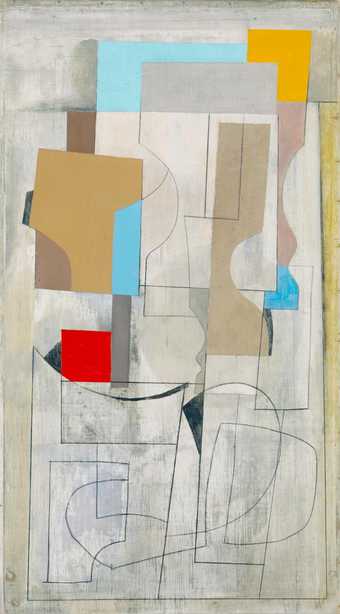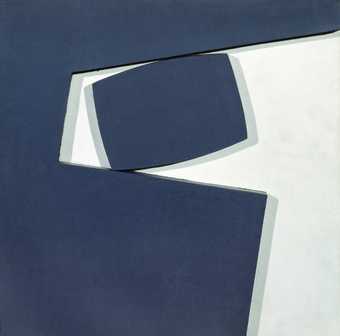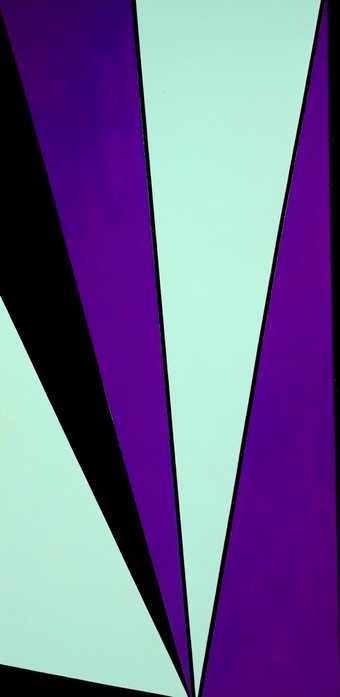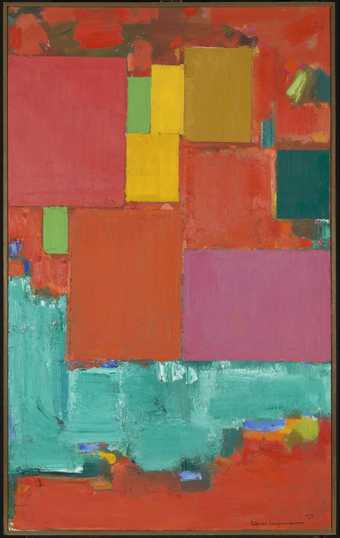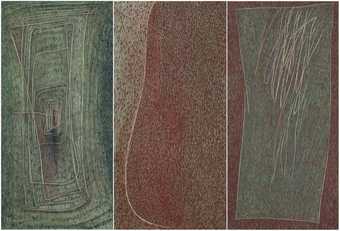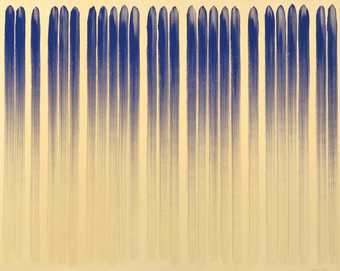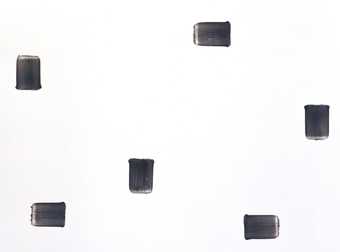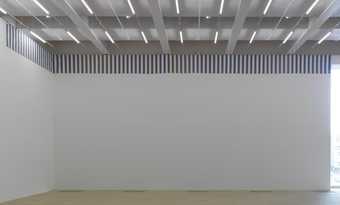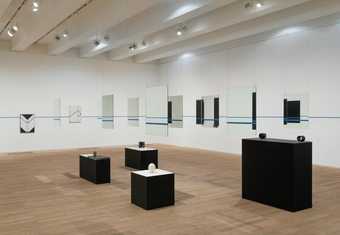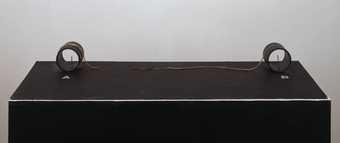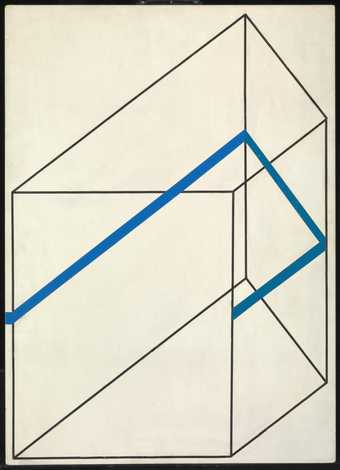
In Tate Modern
- Artist
- Edward Krasinski 1925–2004
- Original title
- Interwencja 15
- Medium
- Tape and paint on hardboard
- Dimensions
- Support: 699 × 500 × 33 mm
- Collection
- Tate
- Acquisition
- Presented by Tate International Council 2007
- Reference
- T12568
Summary
T12568 is an axonometric painting, with black acrylic lines depicting a white three-dimensional geometric object on a black background. The term ‘axonometric’ refers to a drawing method used to represent a three-dimensional object on a two-dimensional support – vertical lines are drawn to scale, but the diagonals are distorted in order to give the illusion of depth and volume. The painting also features Krasinski’s signature blue Scotch tape, which has been positioned so that it appears to pass from the wall to the left of the painting onto the canvas, following the contours of the three-dimensional object depicted, and continuing onto the wall to the right of the painting. The strip, which is usually positioned at exactly 130cm from the ground, is therefore subjected to the inner logic of the image.
Krasinski began making these axonometric paintings in 1973. He called them Interventions and displayed them as a series connected with a blue line. Through these paintings, Krasinski explored forms of geometric representation and their relationship to the architectural space of the gallery. As critic Paweł Polit has commented, Krasinski created, ‘a kind of visual narrative between two heterogeneous realms: a real space, exposed to the contingencies of passing time, and an ideal, timeless space of geometry’ (quoted in Breitwieser, p.74). Krasinski was a close friend of Henryk Stażewski (1894–1988), a key figure of the Polish avant-garde of the 1920s and 1930s and a representative of the constructivist movement. Despite the importance of line and geometric space to Krasinski’s work, it seeks to challenge the logic of geometry and three dimensional space that constructivism took for granted. As the curator Lena Kiessler comments: ‘The properties of the material, its inherent reactions to certain physical forces, are not respected by Krasinski and become involved in a visual game. We could therefore speak of a critique of visuality, where all trust in the visual comprehension in perceptual experience is deceived.’ (Kiessler and Mytkowska, p.5.)
Krasinski first used the blue strip that would become his trademark in 1968. He progressed from simply sticking the strip in surprising places to making assemblage constructions that incorporated it. As he explained: ‘I wanted to “pull” something out of the wall; I framed parts of reality, like a fragment of my door with the handle and the frame and made a picture out of it’ (quoted in Breitwieser, p.22). For the Tokyo Biennale in 1970, Krasinski’s works were delayed in shipping. He sent a telex to the organisers containing the word ‘BLUE’ repeated 5000 times, along with instructions to display the roll of perforated telex paper with the code for the word ‘blue’ on it (reproduced in Breitwieser, p.182). After 1974, he turned away from assemblage constructions to concentrate on axonometric designs. As Polit describes, Krasinski not only displayed these images in gallery spaces, but also in such unusual locations as a toilet, a bedroom in his own flat, a hospital, a pigsty and as butcher’s shop (Breitwieser, p.75). Krasinski remained reluctant to discuss the meaning of the tape, commenting: ‘The tape had ascribed meaning to itself. Once it came into being, it was then free to do anything, to frolic. The meaning is inherent in the tape; I inspired only its spirit.’ (Quoted in Breitweiser, p34.)
Born in Polish Łuck, since transferred to Ukraine as Lutsk, Krasinski studied Applied Arts and Fine Arts in Krakow, and began his career in the 1960s as a surrealist painter. In the early 1970s, he moved into Henryk Stazewski’s studio where they lived together, and remained there after Stazewski’s death in 1988. In 1966, Krasinski was one of the founders of the Foksal Gallery in Warsaw, which acted as a focal point for experimental conceptual artists. He participated in the first happening in Warsaw in 1965, initiated by the artist and theatre director Tadeusz Kantor (1915–90), and later played the role of conductor in Kantor’s Panoramic Sea Happening 1967 at Łazy, near Osieki. He began using blue tape in his actions, installations and photo-based works from 1968, often working with the photographer Eustachy Kossakowski (1925–2001). In 1970, he applied tape to the walls of the Musée d’art Moderne de la Ville de Paris and the windows of Rive Gauche galleries. He met Daniel Buren (born 1938) on that occasion, and the two artists remained friends. There is a strong conceptual likeness between the two artists’ work, as both use unchanging and potentially infinite stripes to challenge the definition of art and ways of looking at art (see Buren’s work T12316, One of the Possibilities 1973). Krasinski described the ambivalent and challenging meaning of his use of the blue tape, which became his signature mark: ‘Blue Scotch Tape, 19mm wide, length unknown. I place it horizontally at a height of 130cm everywhere and on everything. I encompass everything with it and go everywhere. This is art, or is it? Yet one thing is certain: blue Scotch Tape, 19mm wide, length unknown.’ (Quoted in Kiessler and Mytkowska, p.83.)
Further reading
Lena Kiessler and Joanna Mytkowska (eds.), Edward Krasinski: Interwencja, Warsaw 2001.
Sabine Breitwieser (ed.), Edward Krasinski: Les Mises en Scène, Vienna 2006.
Paweł Polit (ed.), Edward Krasinski: Elementarz/ABC, Krakow 2008.
Elizaveta Butakova
March 2010
Supported by the London Centre for Arts and Cultural Exchange in collaboration with the Courtauld Institute of Art.
Does this text contain inaccurate information or language that you feel we should improve or change? We would like to hear from you.
Explore
- abstraction(8,615)
-
- non-representational(6,161)
-
- geometric(3,072)
- formal qualities(12,454)
-
- space(177)
You might like
-
Ben Nicholson OM Feb 28-53 (vertical seconds)
1953 -
Henryk Stazewski White-Black Relief No. 6
1962 -
Olle Baertling Ardek
1963 -
Patrick Heron Scarlet, Lemon and Ultramarine : March 1957
1957 -
John Walker Lesson I
1968 -
Richard Smith Early Reply
1972 -
Hans Hofmann Pompeii
1959 -
Antoni Malinowski Trigonal
1991 -
Lee Ufan From Line
1978 -
Lee Ufan Correspondence
1993 -
Patrick Heron Yellow Painting : October 1958 May/June 1959
1958–9 -
Daniel Buren One of the Possibilities
1973 -
Edward Krasinski Untitled
2001 -
Edward Krasinski Untitled
1968 -
Edward Krasinski Intervention 27
1975

